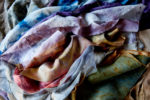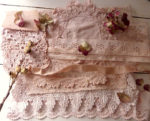Interested in dyeing your own fabric but hesitant about using chemical dyes? If you’ve ever wanted to try your hand at creating your own colors and patterns but feared the amount of work and equipment it takes to use something like RIT, you might want to consider beginning with natural dyes.
Natural dyes incorporate things you already have on hand, such as fruit, vegetables, tea, and a day full of sunshine. Creating your own dyes is an inexpensive, rewarding way to use up things like old bouquets, spices, coffee grounds, and other things we’d normally throw out. It takes very little equipment, and the results are always unique and interesting.
The first way to use natural items to make a dye is to use leftover fruits, vegetables, and flo
wers. There are plenty of foods that leave beautiful yellows, purples, blues, greens, and browns. You can use anything from onion skin to red cabbage to orange peels, saffron, and spinach. You will also need water and a saucepan and jar for each color, along with salt and vinegar to fix the colors.
You can find a guide to natural food dyes at MAIWA BLOG, and a tutorial at Pop Sugar. If you want to try “flor
al imprinting”, you can find a how-to at Eye Swoon with plenty of gorgeous photos for inspiration.
If you, like me, always have an array of tea handy, you can try tea staining, which gives fabric a beautiful, vintage look. All you need for this type of dye are tea bags, water, salt, and a saucepan. You can use this for fabric or yarn (crocheted items stained with tea look incredibly beautiful). Using different types of teas, such as black tea, green tea, or herbal tea will result in different shades of neutrals. Try using swatches first before committing to make sure you have the color you want.
You can find a great tutorial on tea staining at Lost In Paris.
Of course, if you want to try incorporating regular dye and natural processes, you can try sun printing. Use your favorite sun dye brand, such as Dye-Na-Flow (a non-toxic fabric paint), a day full of sunshine, and a collection of leaves, petals, and stems to create a composition that you can use for wall-hangings, framed prints, or sewn objects. I’ve always found this method to be intriguing, and it’s less intensive than some of the other processes.
You can find a wonderful tutorial with stunning photos of the results over at Dieu Wertje Maakt (instructions are in English).
Whichever method you choose, it’s a rewarding way to utilize materials that would otherwise be thrown away, and the results are worthy of being shown off or made into gift items for friends and family. I have a pillowcase from a friend who dyed it using saffron, and the happy yellow color always reminds me of him. It’s a meaningful gift, one I will always treasure.



